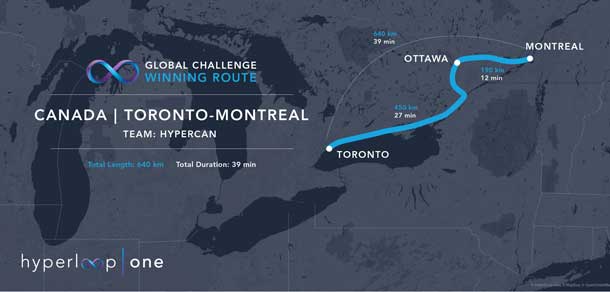Imagine living in Montreal, working in Toronto and being home for supper in the evening. That’s the near-future world that Sarah Hanson, Engineer-In-Training, invited guests at the annual Professional Development Lunch to consider.
Hanson is a transportation planning professional with AECOM Canada and is the team lead of AECOM HYPERCAN, a project approved under the international Hyperloop One initiative.
Hyperloop is a new mode of transportation that moves freight and people quickly, safely, on-demand and direct from origin to destination. Passengers or cargo are loaded into a pod which gradually glides above a magnetic levitation track inside a near-vacuum low-pressure tube. By minimizing air and ground resistance in these ways, the train can travel at airline speeds – over 1,000 kilometres an hour – using relatively little energy and with no direct carbon emissions.
The international Hyperloop One organization issued a global challenge for proposals for places where the first Hyperloop pilot projects could be built. AECOM’s proposal, which involves a route between Toronto, Ottawa and Montreal, was accepted as one of the top 10 in the world.
The Toronto-Ottawa-Montreal corridor is the most heavily travelled inter-regional corridor in Canada. The metropolitan areas combined contain over 25 per cent of the population of Canada. This corridor has the population base, existing travel demand and geography to support an operational Hyperloop.
Historically, there has been interest and public support for improved connections through the corridor (particularly high-speed rail), including provincial and federal feasibility studies.
The freeway connections between Toronto, Ottawa and Montreal are the busiest freeways in Canada. The annual average daily traffic on Highway 401 exceeds 450,000 vehicles within the City of Toronto alone and never drops below 20,000 between urban centres along the route. As well, VIA Rail (Canada’s passenger rail service) earns 67 per cent of its revenue within the Quebec-Windsor corridor and all the major air carriers in the regional market offer dozens of daily flights between the three cities.
But all of these existing methods of transportation have drawbacks, not the least of which is wasted time. Under ideal conditions, the drive from Toronto to Montreal is a minimum of five hours.
HYPERCAN would turn travel among these cities into little more than a long subway ride. An express trip from Toronto to Montreal would take 45 minutes. Travel from Toronto to Ottawa would be a bit more than half an hour. A non-express trip from Toronto, stopping in Ottawa and ending in Montreal would take less than an hour.
But faster commutes aren’t the only goal of the Hyperloop. HYPERCAN envisions bringing these centres closer together to form what Hanson calls a “mega region.”
“With a combined population reaching 16.5 million in 2040, the region would be well-positioned to rival with major North American metropolitan areas to attract workers, visitors, businesses and investment.”
Through its capacity to move freight, Hyperloop would also enhance the region’s position as a trade centre. It would allow goods imported through the Port of Montreal to be moved almost instantly to Toronto for redistribution to other centres across North America. Going the other way, the system would permit Canadian goods to reach the Port of Montreal much faster, which would bolster Canada’s export position.
“This is a phenomenal opportunity to create a New Canada that can compete better in the global economy,” Hanson says.
But AECOM is also already envisioning the next steps for Hyperloop beyond Canada’s borders, such as potential branch lines to Niagara, Buffalo and New York City – a world in which Toronto residents could catch a Broadway show and be back in their own beds that night.
While the HYPERCAN vision is exciting, it is also a long way off. Although governments at all levels have been supportive of the project to date, there is still a long road of government engagement – not to mention bureaucracy – for the project to travel. At a projected price tag in excess of $30 billion, AECOM expects the project will not likely be built public funds alone but will require a serious level of private-sector investment, possibly through a P3 structure.
Once government backing and potential funding sources are secured, HYPERCAN will have to go through the usual process of any major engineering project such as feasibility studies, preliminary designs and environmental assessments.
But Hanson is confident the pieces will come together.
“HYPERCAN will happen. It’s not a matter of if, it’s a matter of when. It represents a big investment but it also delivers big returns for the economy and the environment.”
As an engineer, Hanson is proud to have the opportunity to contribute to the project.
“We engineers strive to build the cities of the future – something better for our children, something resilient. That’s what we are doing with the Hyperloop project.”
